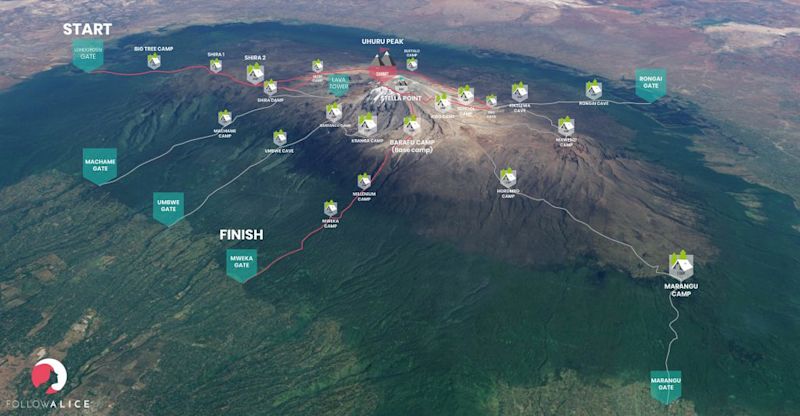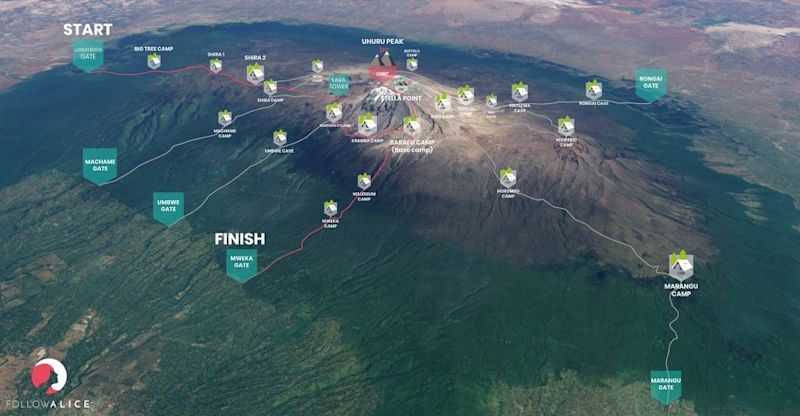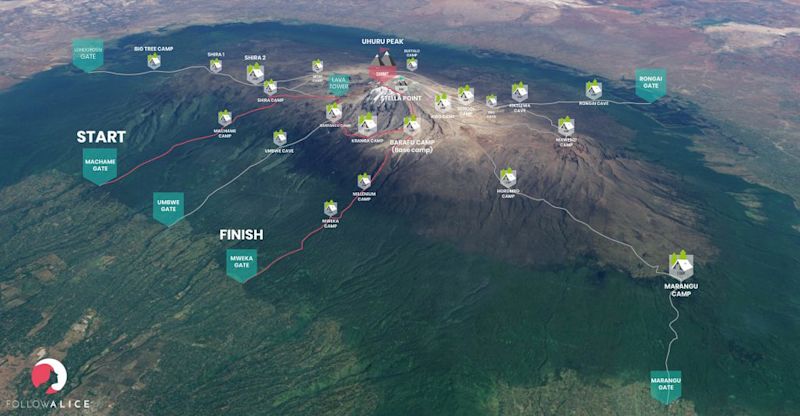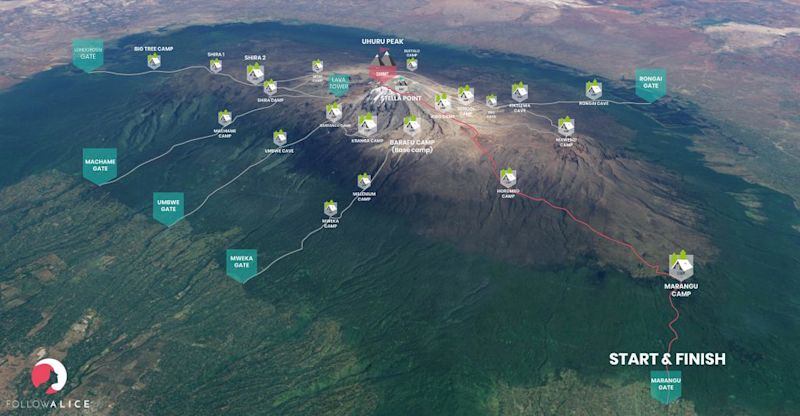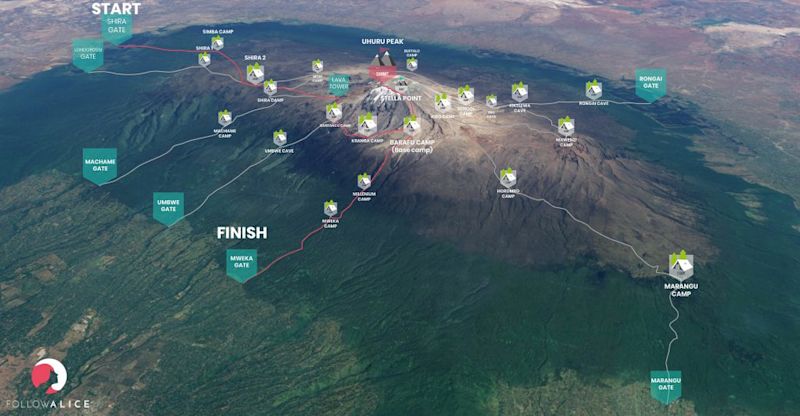When it comes to Kilimanjaro's seven different routes, not all are created equal. For from it.
An important part of your Kilimanjaro preparation is deciding which of the seven routes leading up the mountain you should climb. Unless you’re a highly experienced high-altitude trekker who knows they can acclimatise quickly, we recommend that you always make acclimatisation your number one deciding factor in choosing a Kilimanjaro route.
This is because inadequate acclimatisation can lead to medical complications as well as having to turn back down the mountain. Getting all the way to Tanzania and starting up Kilimanjaro to only have to turn back before the summit … crushing.
So with all of that said, here's how we at Follow Alice rank the different Kilimanjaro routes in terms of acclimatisation based on our collective expertise gathered over many years of leading trekkers up and down the mountain via the various routes.
Please note that you should read What is the best way to acclimatise when climbing Kilimanjaro? for an explanation of acclimatisation if this concept is new to you.
#1: The Northern Circuit route
Map showing the Northern Circuit route (the route is in red)
The Northern Circuit (also known as the Grand Traverse) is the very best Kilimanjaro route in terms of how well it lets you acclimatise. This arguably makes it the best Kilimanjaro route full stop, since altitude sickness is the number one cause of trekkers not managing to complete the climb.
What makes the Northern Circuit such an excellent route in terms of acclimatisation?
There are three reasons.
Firstly, your starting elevation is very healthy: above sea level (asl).
Secondly, the route takes nine days to complete, which means you take eight days over the ascent. No other route spreads the ascent over so many days. The longer you give your body to acclimatise to the altitude gains of a Kilimanjaro climb, the smaller the chance you have of developing altitude sickness.
Thirdly, on Days 6 and 7, you hike and sleep lower than you did on the Day 5. Including a substantial 'dip' during your overall ascent is a well-known high-altitude-trekking strategy that does wonders for your acclimatisation. This is because you introduce your body to a new and taxing elevation but then you let it recover for a bit at a lower elevation where it can enjoy a higher oxygen intake.
Note that while some other Kilimanjaro trails also include a dip, no other route offers one that lasts for so long: in other words, for two days instead of just one. This prolonged dip helps Northern Circuit trekkers to acclimatise really well and so they then manage to reach the summit of Kilimanjaro far more often than trekkers on all of the other routes.
We highly recommend this route to anyone wanting to trek Kilimanjaro – it offers you your very best chance of summiting the mountain!
The Northern Circuit offers the best acclimatisation of any Kilimanjaro route. It consequently has the highest summit success rate.
#2: The Lemosho
Map highlighting the Lemosho route (the route is in red)
The Lemosho route can be hiked over seven or eight days. While both durations offer good acclimatisation, please note that it's the eight-day version that we're ranking in spot number two! This version lets you acclimatise very well, and as such is an excellent route.
The first reason for us saying that it offers very good acclimatisation is that you start at Lemosho Gate, which is 2,100 m asl and is a very sensible starting elevation. The ill effects of high altitude usually kick in at around 3,000 m asl, so you want to start trekking substantially lower than that and work your way slowly up towards that elevation.
The second reason we say that the Lemosho route offers very good acclimatisation is that it lets you ascend the mountain slowly: over seven days. This is enough time for most people to adjust well to the altitude gains without placing their bodies under undue strain.
The third and final reason it offers very good acclimatisation is that Day 4 sees you climb to Lava Tower at 4,630 m asl before descending to Barranco Camp at 3,967 m asl for the night. This is a substantial dip of over 600 m and as such is highly beneficial to your body.
By allowing trekkers plenty of time to acclimatise, the Lemosho has one of the best summit success rates of all Kilimanjaro routes. We're very happy to recommend the eight-day Lemosho to anyone looking to climb Kilimanjaro.
#3: The Machame
Map showing Machame route on Kilimanjaro (route is in red)
The Machame route can be hiked over six or seven days. We encourage everyone to opt for the seven-day route as it offers better acclimatisation. And it's this seven-day itinerary that we're ranking in third place alongside the Rongai route, as the ascent takes place over six days, which is the minimum number of days we would recommend for a Kilimanjaro climb to ensure you're not taking too big of a risk with your health.
Another factor in its favour is that the Machame route starts at Machame Gate, which is 1,640 m asl – a fantastic starting altitude.
Finally, a third reason for ranking the seven-day Machame high on our list of the best Kilimanjaro routes in terms of acclimatisation is that on Day 4 you hike up to an all-new elevation at Lava Tower at 4,630 m asl and then descend to sleep that night at Barranco Camp at 3,967 m asl. As discussed, dipping down in altitude for a spell during your overall ascent really helps the body to acclimatise well.
We’re happy to recommend the seven-day Machame route to seasoned or even novice trekkers, even if it's not our first choice for the latter group.
#4: The Rongai
Map showing the seven-day Rongai route on Kilimanjaro (route is in red)
The Rongai is a six- or seven-day trail, but it's the seven-day version that we're ranking in spot number four of this acclimatisation list.
The route starts at Rongai Gate which is 1,950 m asl. This is a great starting elevation, and as such sets you up for good acclimatisation.
Next, similar to the seven-day Machame route, the seven-day Rongai route gives you six days for the ascent, which is a reasonable amount of acclimatisation time, if not ideal.
The reason we don't rank the seven-day Rongai as highly as the seven-day Machame is that the Rongai doesn't include a helpful overnight dip during the ascent. That said, we're still happy to recommend this route to clients who understand the potential risks involved.
#5: The Marangu
Map showing the Marangu route on Kilimanjaro (route is in red)
The Marangu route offers a slow and steady climb. It’s therefore one of the easiest routes from a hiking point of view.
That said, the big con of this route is that it asks you to ascend to the summit over just four or five days. This is just too short. Yes, the five-day version has a dip in its profile on Day 4, which is helpful in terms of acclimatisation. But this isn't enough to offset the problematically fast ascent.
Finally, there are other reasons to prefer the other routes over the Marangu, and consequently we don't ever recommend this route. (You can learn more in this regard by reading The seven different Kilimanjaro routes – pros and cons of each.)
#6: The Shira
Map showing the Shira route on Kilimanjaro (route is in red)
The Shira route usually takes place over seven days. It starts at Shira Gate, which is 3,600 m asl. And this is the problem. That’s the same elevation as La Paz, Bolivia, the highest administrative capital in the world.
Those who start trekking Kilimanjaro at Shira Gate begin their trek almost two vertical kilometres higher than everyone else trekking the mountain. More to the point, however, is the fact that this altitude is just too high for most of us when we've been transplanted there by vehicle from a much lower altitude. You need to ease your body into any elevation over 3,000 m asl.
On the other Kilimanjaro routes, you spend a couple of days hiking up to the same elevation as Shira Gate, and that hiking forms an important part of the body’s acclimatisation process.
With this in mind, we don’t recommend opting for the Shira route unless:
- You’re a highly experienced high-altitude climber who knows your body can cope with high starting altitude
- You've just just completed a pre-acclimatisation trek such as climbing neighbouring Mt Meru.
- You live at a similar altitude to the route's starting elevation.
#7: The Umbwe
Map showing Kilimanjaro's Umbwe route (route is in red)
The Umbwe is the shortest and steepest Kilimanjaro route. You trek the entire route over just six days. On four of the five ascent days, you climb at least one kilometre in elevation. Your body therefore has very little time to adapt to the lower oxygen levels associated with each altitude gain.
We don't recommend the Umbwe to anyone except perhaps:
- Highly experienced high-altitude trekkers who know their bodies can cope with the steepness of the trail and its rapid altitude gains.
- The ultra fit who have just completed a pre-acclimatisation trek such as climbing Mt Meru.
We hope you found this list helpful. If you'd like to discuss anything with us, please don't hesitate to contact us. We're more than happy to chat things through with you.


